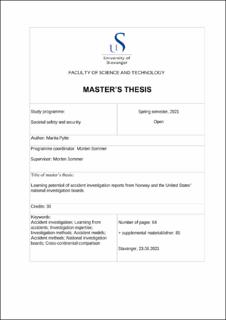| dc.description.abstract | Accident investigations are an important tool for learning from accidents, by giving insight into what went wrong, and how to prevent similar accidents from happening in the future. However, there is a lack of standard guidance regarding best practices for how to execute such investigations. There are a plethora of different aspects to these investigations, as well as different alternatives and approaches for each aspect. The purpose of this thesis is to investigate how a few of these aspects might influence the outcome of the investigations, and how this in turn can influence learning potential.
To answer this, the objective of this study was to find out what influence standard procedures, investigation methods, expertise, and accident models have on conclusions and safety recommendations. The study has focused on two accident boards from two different countries: the Norwegian Safety Investigation Authority (NSIA) from Norway and the National Transportation Safety Board (NTSB) from the United States. They were chosen to highlight potential cross-continental differences that could give valuable insight that both sides can learn from.
The research in this thesis was done mainly through comparative document analyses, both a quantitative and qualitative approach. The qualitative analysis was used to gain insight into the fundamental differences between the two boards and entailed official documents from the two boards, as well as relevant laws and regulations regarding their mandate and responsibilities. This was in turn used as potential explanations for differences found through the quantitative analyses. The quantitative analyses included railway accident reports from the last decade and investigated the effect the different aspects had on the report’s focus, safety recommendations, socio-technical levels, and conclusions.
The data collection, hypotheses and conclusions were all done in light of the theoretical context of the thesis. Throughout the thesis, I have relied on Hollnagel’s three major groups of accident models consisting of sequential, epidemiological, and systemic models; Rasmussen’s socio-technical levels; and Argyris and Schön’s distinction between double-loop and single-loop learning. Furthermore, I chose to focus on the three accident models AcciMap, MTO and STEP. This theoretical context must be considered when reviewing the results and conclusions made in this thesis.
The results from the analyses implied that different standard procedures, expertise, and accident models all have a significant effect on the outcome of investigations and may influence learning potential. A larger cross-sectoral investigation board with more diverse expertise appears to give a more even distribution of safety recommendations between the different socio-technical levels, and more focus to higher levels. This could provide learning to more of the levels, as well as increasing double-loop learning by including higher levels.
The results also indicate that epidemiological accident models give an increased focus on human causal factors, while systemic accident models lead to an increased focus on organizational factors. Lastly, investigation methods did not have any apparent effect, possibly due to the two accident boards having similar approaches and overlap. Both the NSIA and the NTSB have different aspects that can influence their learning potential in positive and negative ways, and it would be beneficial for both of them to learn from each other’s approaches to increase their learning from accidents. | |
